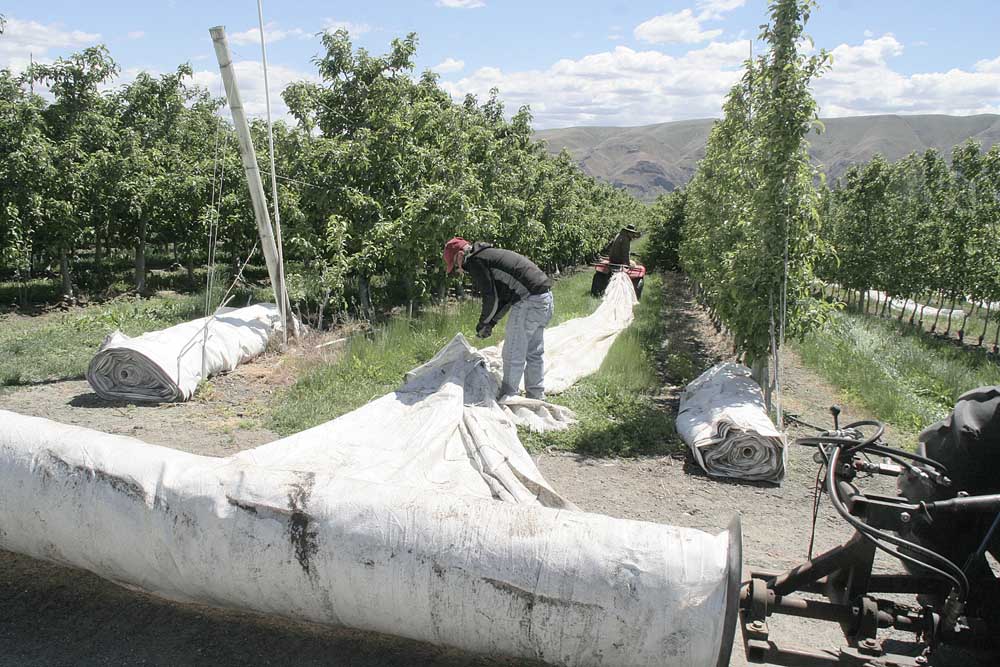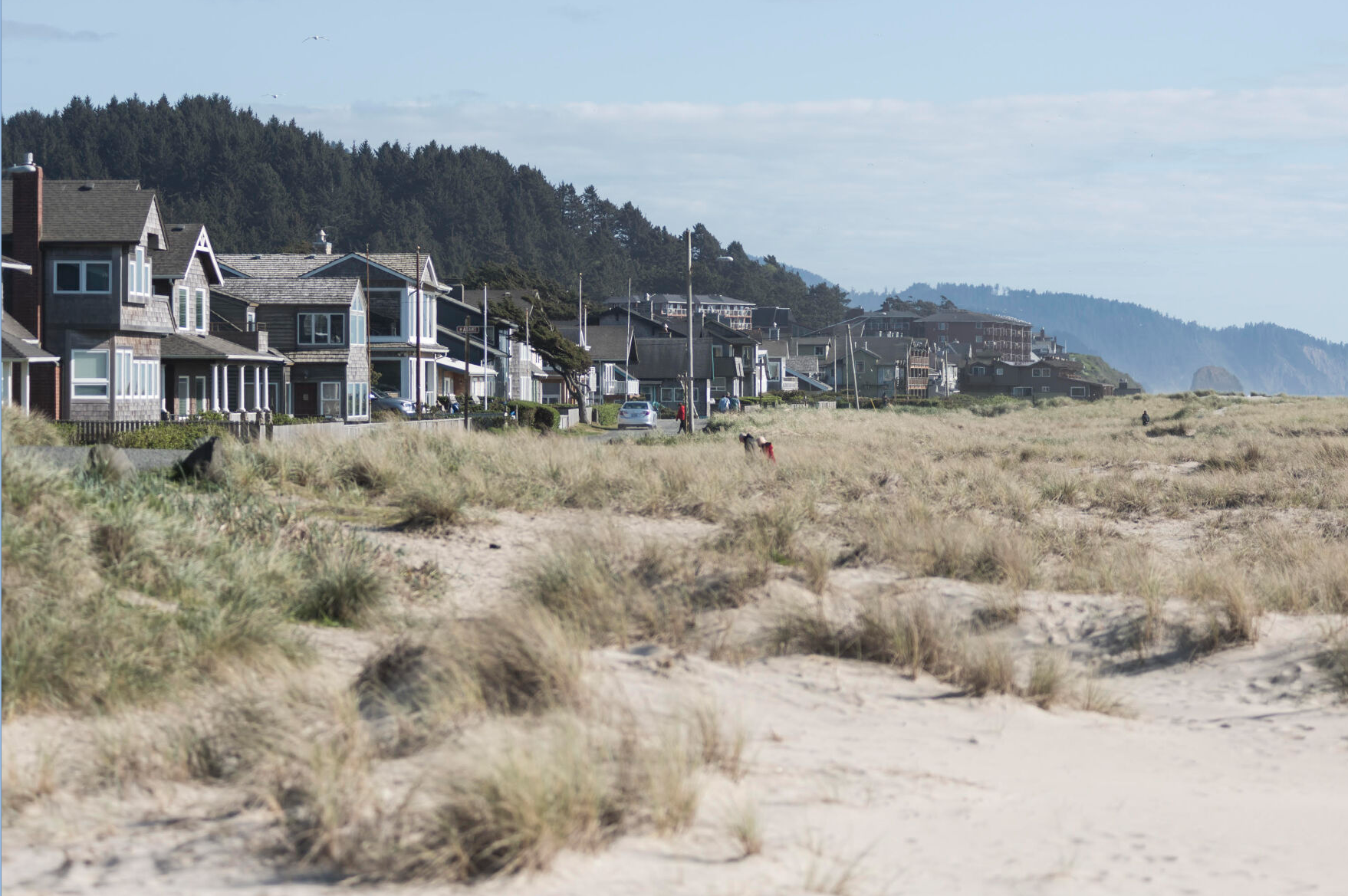Ag faces big labor shortages
Published 5:16 am Tuesday, May 30, 2017

- Benjamin Lugo ties pieces of Extenday reflective fabric together as Fernando Licona pulls it down a row on an ATV at Lyall Orchards in Mattawa, Wash., this month. The fabric helps ripen fruit. They are year-round workers but owner Charles Lyall is concerned about having enough pickers through harvests.
It’s three weeks before the start of harvest and the Chelan Fruit Cooperative is short hundreds of workers needed to pack this year’s cherry crop. General Manager Reggie Collins worries about whether some of the crop will have to go unpicked in June and July.
Trending
“Last year, we were scared to death and we were able to get barely enough for our packing lines with high school kids. This year it looks shorter,” Collins said from the co-op’s offices in Chelan, Washington.
“Three weeks before cherry season last year, we had 241 new applications beyond our regular staff. This year we have 40,” he said. “We’re probably 400 short right now and we will start packing on the 10th or 12th of June.”
Some 840 miles to the south, Scott Brown, production manager of Morada Produce in Linden, California, says the largest cherry crop in years has labor stretched so thin that companies are making tough choices, based on quality and volume, of which orchards to pick and which to pass over.
Trending
In Idaho, grower Duane Grant, of Rupert, used to get two applications for every seasonal job opening on his large, diversified farm. Now he gets so few applications he’s joined a growing number of farmers who turn to foreign guest-workers.
In Oregon, the demand for farmworkers is outpacing the workforce, Kevin Chambers, owner of Koosah Farm in Amity, told a recent immigration summit.
“What we have is a relatively fixed pool of laborers, and a growing need,” he said. “We’re planting more acres of grapes, hazelnuts — there is greater demand for labor.”
Across the Pacific Northwest and California, finding enough labor for tree fruit, berries, hops — any labor-intensive crop — is heavy on the minds of growers, packers, shippers and marketers. It’s magnified, several said, because fewer people are apparently illegally crossing the U.S.-Mexican border to do farm work and by media hype of the Trump administration’s deportation of illegal immigrants, which heightens fear among some workers.
Rose Richeson, U.S. Immigration and Customs Enforcement spokeswoman in Seattle, said the biggest difference in the ICE arrest policy under the Trump administration is that no category of individuals in violation of immigration laws is excluded from possible enforcement action. In the past, some were not a priority, she said.
Immigrants who enter the country illegally and who are convicted criminals or a security risk are the priority targets for arrest, and the number of them arrested has risen substantially, she said. Other undocumented immigrants, while not a target, may also be arrested, though in the past that was less likely, Richeson said.
She said the rumors surrounding ICE’s activities are inaccurate.
“Reports of ICE checkpoints and sweeps are false, dangerous and irresponsible,” she said. “Any groups falsely reporting such activities are doing a disservice to those they claim to support.”
Another big factor in the labor shortage is the red-hot economy in places such as Idaho. Though the labor pool there continues to grow, new and expanding processing and manufacturing plants are tapping the labor pool and pushing the state unemployment rate to 3.3 percent, a level economists label full employment.
Oregon also has a tight labor market, with a 3.7 percent preliminary unemployment rate for April, according to the U.S. Bureau of Labor Statistics. California has a 4.8 percent unemployment rate and Washington state’s is 4.6 percent.
“The No. 1 issue in the industry right now is labor. It really is. I would say there’s a general feeling of greater intensity and concern on labor than in a number of years,” says Chuck Zeutenhorst, general manager of First Fruits Marketing of Washington, in Yakima.
“There has been so much negative press and misinformation and fake news about (President Donald Trump’s) real policies, and unfortunately that drives fear into people,” Zeutenhorst said.
There’s a lot of angst about Trump rounding up undocumented immigrants who have committed serious crimes but former President Barack Obama deported 2 million undocumented immigrants, he said.
“We hope the Trump administration comes up with a thoughtful immigration policy that works,” Zeutenhorst said. “We haven’t had a positive one for the past eight years.”
First Fruits markets for Broetje Orchards and two other producers. Broetje operates more than 5,000 acres in the Tri-Cities area of southeastern Washington. It’s one of the largest companies that relies solely on domestic labor without using the H-2A visa foreign guest-worker program.
Many large Washington tree fruit companies do rely on H-2A workers, estimated to reach 15,000 this year. The program is expensive, requiring employers to pay at least $13.38 per hour, and provide housing and transportation between the farm and the worker’s country of origin, usually Mexico.
Broetje employs about 2,200 workers for picking and packing cherries and about 4,000 for the apple harvest. It’s too early to know whether the company will have enough this year, Zeutenhorst said.
Broetje pays well and takes care of its workers but some day may have to turn to H-2A, he said.
August and September will be stressful, he said, because the harvests of apples, grapes and hops will all compete for the same workers.
Stemilt Growers of Wenatchee, Washington, one of the largest cherry packers with operations in Wenatchee and California, last season needed 1,500 workers for two Wenatchee cherry packing plants for double shifts at season peak.
This year, the harvest will likely be spread over more days so fewer people will be needed, said West Mathison, Stemilt president.
Mathison said he was concerned a month ago, but now has recruited 80 percent of the people he needs and has three weeks to recruit the rest.
“With our good employee facilities, our free health care clinic and long season we feel we will be able to recruit enough good people. With near record low unemployment, we know it will be tight,” Mathison said.
Several Washington growers who rely on domestic workers said they won’t know the severity of any labor shortage in cherries until the latter half of June.
Several others said there is a labor shortage but that they have enough domestic workers because they pay well or provide housing, or both, and generally treat their workers well.
Brenda Thomas is president of Orchard View Farms in The Dalles. With about 2,400 acres, Orchard View is the largest cherry grower in Oregon. The company is doing OK so far, recruiting online with many workers planning to return after making good money there last season, she said.
“We don’t want anything happening between now and harvest with any fake news,” Thomas said, adding that it creates fear.
There’s a different feel, a fear of the unknown by employee and employer, she said, from perceptions about deportation when “they won’t look at your immigration (status) unless they pull you over for another crime.”
There is a shortage, she said, because there are no extra people anymore looking for work.
Orchard View Farms does well without H-2A, she said, because it provides housing for workers, pays well on piece rates averaging $20 per hour, has a good work environment and a long season.
“We want to be the preferred choice for work,” Thomas said. The company peaks at about 1,100 workers for picking and packing, she said.
“Over 80 percent of our workers come from communities in California where their kids go to school. They come up and work and count on our cherry harvest to fill their gap in California harvests,” she said.
Reporters Tim Hearden, John O’Connell and Eric Mortenson contributed to this story.









